“You still don’t understand what you’re dealing with, do you? Perfect organism. Its structural perfection is matched only by its hostility.”
Ash, Alien (1979)
35 years ago the perfect organism returned to cinema screens in the perfect film sequel, Aliens. Along with Blade Runner, Aliens imbued many an impressionable young film lover, myself included, with sky high, downright unreasonable expectations of what to expect in the cinema. Whether watching any movie be it action, sci-fi, or horror, or any sequel, Aliens is still the high bar by which all others are judged.
Cameron’s sequel expanded on Ridley Scott’s original in so many ways – without denigrating it – that it’s difficult to know where to start, so I’ll begin with my own experience with the film.
I was too young to experience Aliens when it first came out. Instead I was exposed to it, in the same manner the marines explored the atmosphere processor, one level at a time.
My first taste: the tech. As outlined in The Making of Aliens book, by J.W. Rinzler (which I will be quoting from liberally here):
It was Cameron who designed the weaponry for his Colonial Marines. “Part of the attraction of doing the film was that it was a design fest,” he said, “an opportunity to do all sorts of wonderful hardware. I like hardware a lot. As a filmmaker, I don’t want to be a slave to it, but the hardware has to be up to certain standards.”
The Making of Aliens, J.W. Rinzler
Peace Through Superior Firepower

Cameron may not have wanted to be a slave to design, but it takes such a commanding role that, like Blade Runner before it, it conjured up a fully realised, lived in world, outside the confines of the Nostromo. The fantastical future world of Aliens, built on the space trucker aesthetic of Alien, still retained a feeling of authentic realness to it.
From the grating of the floor panels in the Hadley’s Hope Colony, to the marines body armour, the armored personnel carrier (APC), and the iconic ping of the motion tracker, the design work of Aliens is staggering. Just because it has become the de facto design language when it comes to “grunts in space,” in everything from Starship Troopers to Halo, shouldn’t take away from the fact that it all had to be dreamed up and made, by hand.
My own entry to the world of Aliens was via the UD-4 “Cheyenne” Dropship, Bug Stomper. I caught a fleeting glimpse of the marine’s deployment to LV-426 while making sure the VCR timer had gone off and recording Aliens off a free trial of Sky Movies for my cousin. The “express elevator to hell,” along with James Horner’s pounding war drums, and the colonial marines looked like nothing I’d ever seen before. Admittedly, I hadn’t seen very much at that stage but this very clearly wasn’t Star Wars.
We’re in the Pipe, Five by Five
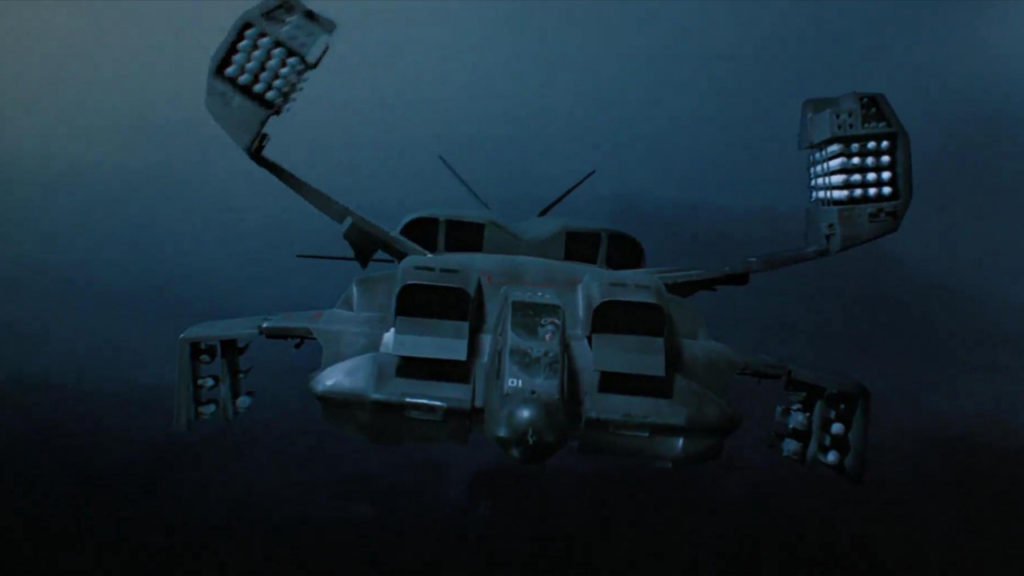
Like Star Wars though, despite the different designers involved, everything felt like part of the same world. This wasn’t a sci-fi world where one or two pieces of technology differentiated it from from our world, this was a cornucopia this felt like a world. The sound and flare of the pulse rifles. Drake and Vasquez’s smart guns and harnesses (even if I still don’t quite understand exactly what these were supposed to do). The Dropship looked like it would sit comfortably in our world but still belonged somewhere else. When I finally got to se the full film, I nearly died when I saw its “weapons pods” unfurl. Years later I would stare longingly at the Halcyon Dropship model in the local arts and hobby shop, ignoring my lack of money and model making skills, trying to decide whether to assemble the kit with the pods in or out, if I ever bought it. ( I never did.)
This could be expected from a film that involved the design work of Syd Mead (Blade Runner, Tron, 2010, Elysium, Blade Runner 2049) and Ron Cobb (the original Alien, as well as Dark Star, Star Wars, Raiders of the Lost Ark, Back to the Future, The Abyss, Total Recall, The Last Starfighter). However the dropship was just one of the many aspects of Aliens that James Cameron decided to do himself.
Not content with either artist’s take, Cameron came in to Pinewood on a Sunday and kit-bashed a prototype together. He started with an AH-64 Apache helicopter kit and modified it with other model parts and foam core, then spray-painted it and handed his model over to Cobb to draw up schematics.
The Making of Aliens, J.W. Rinzler
This was just Cameron’s third feature film as director.
Lovin’ the Aliens
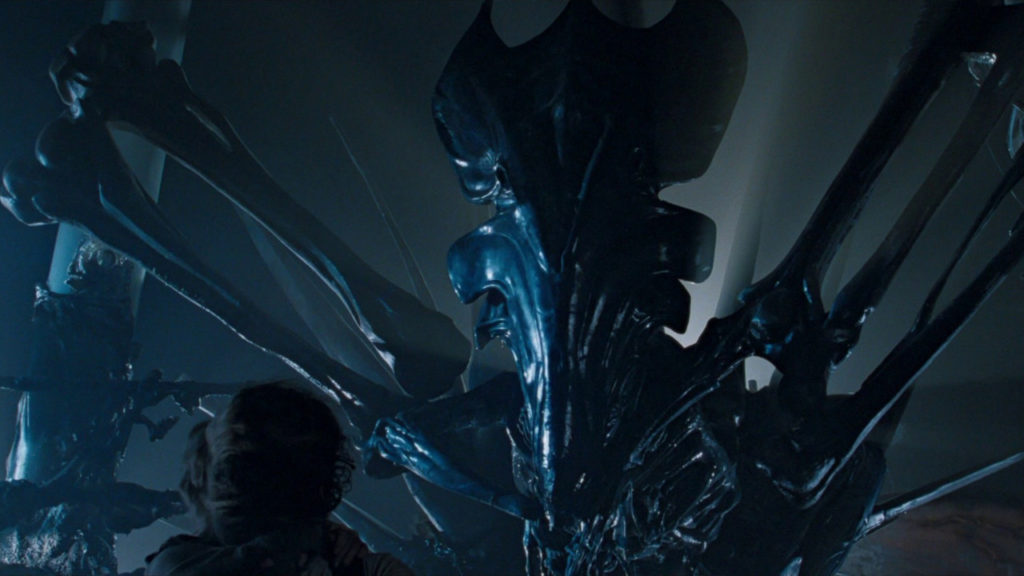
This level of attention to detail is everywhere and in everything in the film.
That’s not to ignore the work of H.R. Giger, without whom there’d be none of this. It’s a testament to his design that the creatures are still so popular. Cameron’s genius however was not just to put more of the Xenomorphs on screen, but to imagine where they came from.
During my next encounter with the film, when I sought out the very videotape I’d made for my cousin at his house, I finally meet them for the first time. In world saturated with Aliens, it might be difficult to imagine what it’s like the first time you see the Alien. And this was not in Alien, where a lone creature stalked the crew from the shadows. No, this was hordes of eyeless, shrieking creatures, utterly overwhelming the coolest, most heavily armed soldiers your tiny brain has ever seen.
I had nightmares for days.
This was just the halfway point of the movie.
I wanted more.
It’s hard to pin down when exactly I saw the whole film. I do recall relaying the film’s ending to my mother after it had screened again on TV after she’d missed the ending. At some stage it became utterly ingrained in the lives of me and my friends. Quotes cropped up regularly in conversation for years afterwards.
“All right, people, on the ready line!”
“I say we take off and nuke the entire site from orbit. It’s the only way to be sure.”
“Look into my eye.”
“Yeah man, but it’s a dry heat!”
“Feel the weight.”
And of course, “That’s it, man. Game over, man. Game over!“
Contents Under Pressure, Dispose of Properly
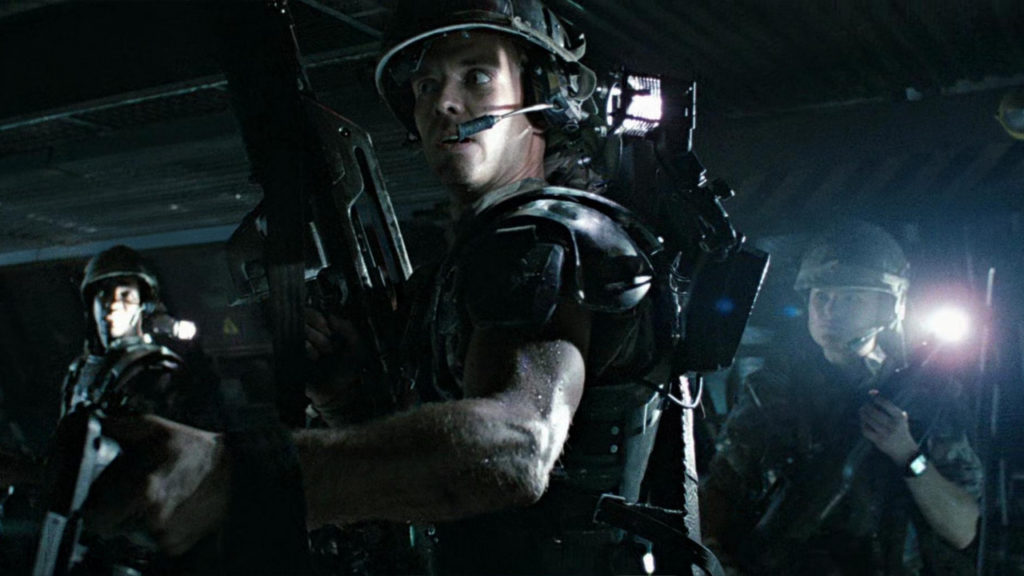
With age came an appreciation of just how good these interactions were. Not just snappy catchphrases but details that further built up these characters. Through a combination of Cameron’s script, the right casting, and a boot camp for the marine characters under the tutelage of Tip Tipping, a former member of the SAS who also appeared as Private Crowe, the on and off screen leadership of former marine Al Matthews (Sergeant Apone), Cameron hadn’t just engaged in a sterile design exercise. This was a squad. He even had the actors personalize their own body armour themselves adding yet another extra layer of authenticity.
As time passed even more layers become apparent. Next, the beauty of the script. This time it’s not just the cold indifference of The Company or the ignorance of the crew of the Nostromo as to what they are dealing with that dooms so many. Hubris plays almost as big a part in Aliens as Sigourney Weaver.
I used to get so mad at Spunkmeyer’s smoke break. That one, ever so human action – having a quick smoke while waiting to get back to work – causes so many problems for everyone. This was after Gorman’s gormlessness results in the marines being stuck in the belly of the beast without their M41A pulse rifle ammo, and the loss of most those marines.
Then there’s the the self serving directives of “The Company’s” bio weapons division, and the actions of its most obvious avatar, that “rat-fuck son-of-a-bitch” Burke (Paul Resier). Everyone overestimates their ability in this movie and fucks up. Everyone except Ripley that is.
This Can’t Possibly Lead to Anything Bad, Right?
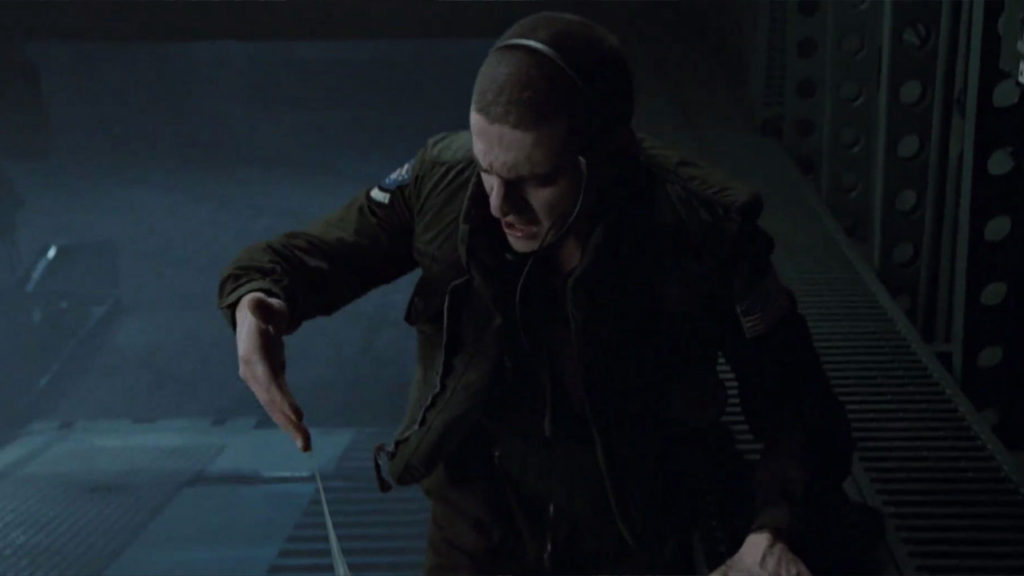
Over time I got less mad because I realized the two reasons behind decisions like these.
- Without the grade-A fuck ups there’d be no movie, and
- This is us in space.
Not the TV show, This Is Us in space, but humanity. Cool technology and space travel doesn’t change the Company’s greed, or middle managers/green lieutenants misplaced confidence in their own untested abilities. The army grunt’s confidence in being able to deal with and/or kill anything they encounter. None of these stand a chance against the perfect organism.
It’s another miracle that Aliens doesn’t end up being a pessimistic film.
Despite the obstacles, Ripley and the “grunts” respond just as we hope we would in the situation. They knuckle down, try to come up with a plan, and flirt with the idea of offing Burke. Even Gorman redeems himself somewhat in his final moments with Vasquez. It is the humanity of the blue collar stiffs of the Nostromo writ large, a “humanity” reflected in the most human non-human of the crew, Lance Henriksen’s Bishop.
Well, I Can Drive That Loader, I Have a Class-2 Rating
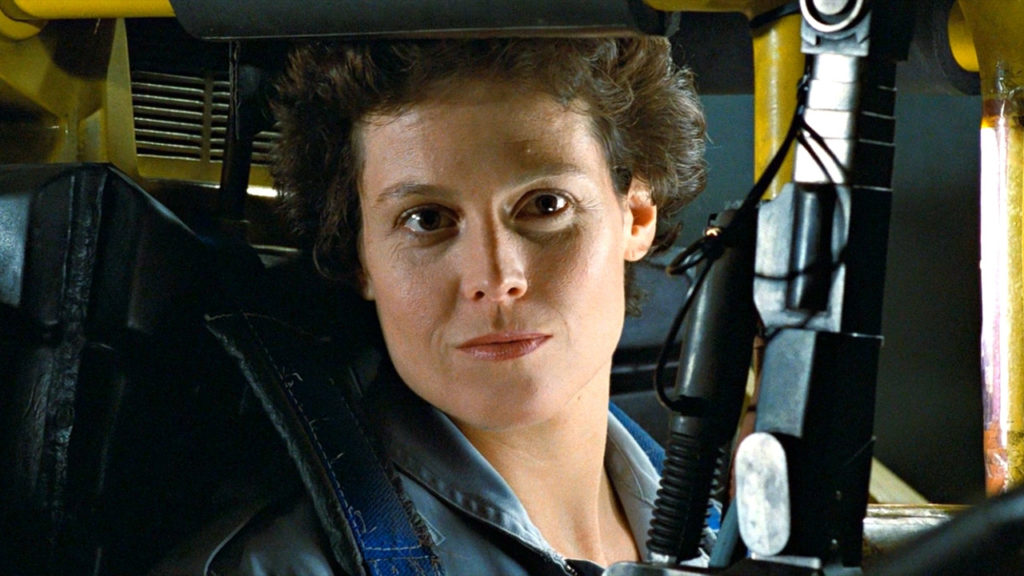
I’ve not even mentioned Ripley yet. It is de riguer these days to have a female action lead as much as a male one, but Cameron didn’t just maintain Ridley Scott’s flipping of Ripley’s gender from the script of first film, he embraced it. Aliens takes Ripley’s “final girl” and forges her into the ultimate mother figure. The Mama with a mecha to combat the Mother of Monsters. Has there been a cinematic brawl that matches the excitement and intensity of Ripley vs. the Alien Queen? Even the recent CGI smash of Godzilla vs. Kong fails to arouse anything near it.
That it’s a fight involving two stuntmen in plastic bags and the Powerloader, another genius bit of cinematic slight of hand, with a stuntman concealed within the loader, behind Sigourney Weaver, makes it all the more amazing.
They Don’t Make ‘Em Like They Used To
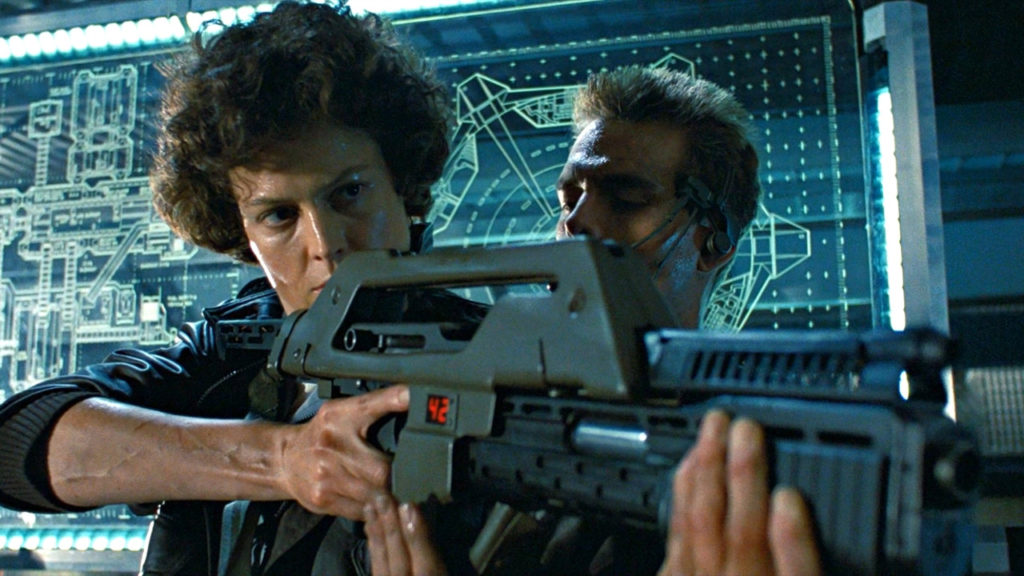
Dr. Peter Venkman : So what? I guess they just don’t make them like they used to.
Ghostbusters (1984)
Dr. Raymond Stantz : [impatiently slaps Peter on the forehead] No! Nobody *ever* made them like this! I mean, the architect was either a certified genius, or an authentic wacko!
After Aliens, The Abyss, Terminator 2: Judgment Day, and True Lies, Cameron became my favorite director. Titanic and Avatar didn’t dethrone him as such, but despite their successes as films as well as at the Box Office, they didn’t quite live up the the imagination on display in Aliens.
Perhaps Cameron will bring even more inspiring designs and stories in Avatars 2 thru 5.
As Aliens passes 35, my biggest worry is that the film be forgotten by younger generations. There’s no chance of that happening to the Alien itself. Its recent appearance in Fortnite, Noah Hawley’s upcoming TV show on FX, or the never ending stream of tie in comics attests to its evergreen popularity. Those first films, however, should not be forgotten, or tarnished by the later entries in the series.
While Disney’s archival processes, and the pandemic, may have put paid to the repertory showings of the film, their presence on Disney Plus should hopefully lead a new generation of film lovers to stumble on them by accident, like I did, and be horrified and enthralled in equal measure.





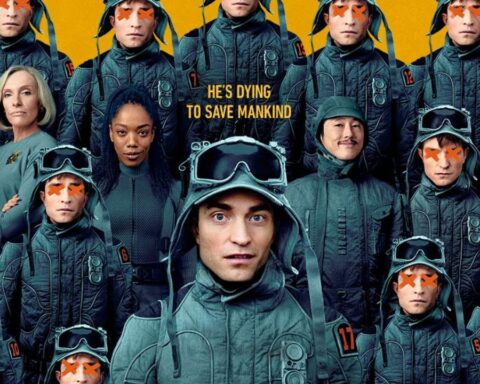
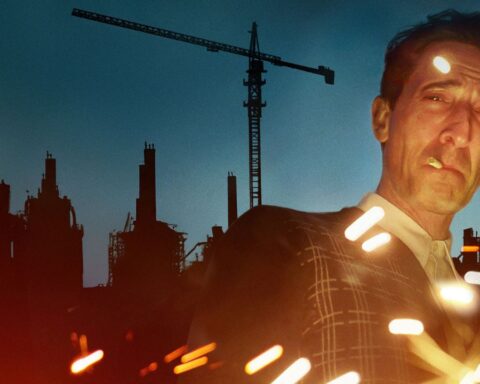


Follow Us